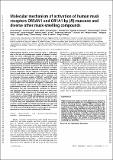Molecular mechanism of activation of human musk receptors OR5AN1 and OR1A1 by (R)-muscone and diverse other musk-smelling compounds
View/
Date
24/04/2018Author
Funder
Grant ID
EP/K022946/1
Keywords
Metadata
Show full item recordAbstract
Understanding olfaction at the molecular level is challenging due to the lack of crystallographic models of odorant receptors (ORs). To better understand the molecular mechanism of OR activation, we focused on chiral (R)-muscone and other musk smelling odorants due to their great importance and widespread use in perfumery and traditional medicine, as well as environmental concerns associated with bioaccumulation of musks with estrogenic/antiestrogenic properties. We experimentally and computationally examined the activation of human receptors OR5AN1 and OR1A1, recently identified as specifically responding to musk compounds. OR5AN1 responds at nanomolar concentrations to musk ketone and robustly to macrocyclic sulfoxides and fluorine-substituted macrocyclic ketones; OR1A1 responds only to nitromusks. Structural models of OR5AN1 and OR1A1 based on quantum mechanics/molecular mechanics (QM/MM) hybrid methods were validated through direct comparisons with activation profiles from site-directed mutagenesis experiments and analysis of binding energies for 35 musk-related odorants. The experimentally found chiral selectivity of OR5AN1 to (R)- over (S)-muscone was also computationally confirmed for muscone and fluorinated (R)-muscone analogs. Structural models show that OR5AN1, highly responsive to nitromusks over macrocyclic musks, stabilizes odorants by hydrogen bonding to Tyr260 of transmembrane a-helix 6 and hydrophobic interactions with surrounding aromatic residues Phe105, Phe194 and, Phe207. The binding of OR1A1 to nitromusks is stabilized by hydrogen bonding to Tyr258 along with hydrophobic interactions with surrounding aromatic residues Tyr251 and Phe206. Hydrophobic/nonpolar and hydrogen bonding interactions contribute, respectively, 77% and 13% to the odorant binding affinities, as shown by an atom-based quantitative structure-activity relationship model.
Citation
Ahmed , L , Zhang , Y , Block , E , Buehl , M , Corr , M J , Cormanich , R A , Gundala , S , Matsunami , H , O'Hagan , D , Ozbil , M , Pan , Y , Sekharan , S , Ten , N , Wang , M , Yang , M , Zhang , Q , Zhang , R , Batista , V & Zhuang , H 2018 , ' Molecular mechanism of activation of human musk receptors OR5AN1 and OR1A1 by ( R )-muscone and diverse other musk-smelling compounds ' , Proceedings of the National Academy of Sciences of the United States of America , vol. 115 , no. 17 , pp. E3950-E3958 . https://doi.org/10.1073/pnas.1713026115
Publication
Proceedings of the National Academy of Sciences of the United States of America
Status
Peer reviewed
ISSN
0027-8424Type
Journal article
Description
We acknowledge support from NSF (CHE-1265679) and NIH (5R01DC014423 subaward) (EB), NIH (5R01 DC014423) (HM), the European Reasearch Council (ERC) and the Engineering Science Research Council (EPSRC) (DO'H), FAPESP and CNPq (RAC), the Chinese Scholarship Council (CSC) for studentship support (MY), National Science Foundation (31070972) (HZ), Science and Technology Commission of Shanghai Municipality (16ZR1418300) (HZ), the Shanghai Eastern Scholar Program (J50201) (HZ). VSB thanks NIH grant 1R01GM106121-01A1 and computational time from NERSC.Collections
Items in the St Andrews Research Repository are protected by copyright, with all rights reserved, unless otherwise indicated.

